Car designers around the world are intimately familiar with it, and the success of the large car making conglomerates are built upon it: platform based design. A limited series of vehicle platforms is used to create many different models with which to flood car dealers around the world. Can the same technology be profitably applied to shipbuilding? The NAVAIS consortium will try to find out.
More than just combining “interchangeable parts”, car manufacturers like Volkswagen have used a systems engineering approach (see text box) to develop scalable modular designs for electrical drive systems, where the same architecture can be used to equip various size cars and scale battery capacity within the same basic architecture.
NAVAIS is a project initiated by Damen (integrator), Dassault Systèmes (software platform provider, the 3DEXPERIENCE® platform for business and innovation, later also referred to as “software platform”) and Bureau Veritas (classification society). In the NAVAIS consortium, they are joined by several smaller, specialised companies, including Eekels, Heliox and Schunck Bahntechnik, in addition to several research and network institutes (MARIN, TU Delft, VITO, CMT, SEA Europe, and Netherlands Maritime Technology (NMT)).
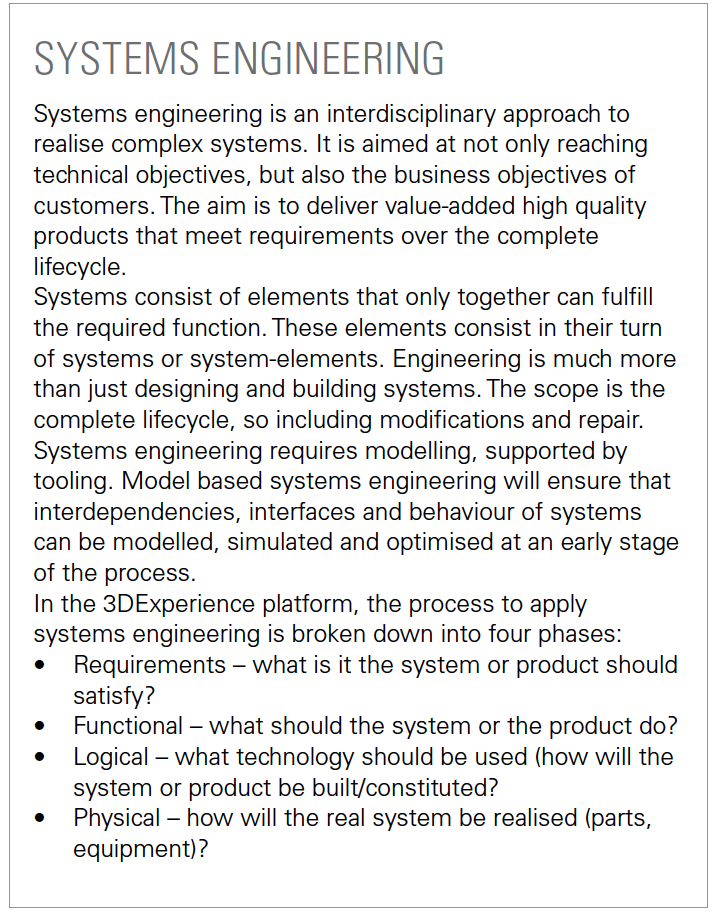
The objective is to make the design and production of complex ships more efficient and strengthen the capabilities to create tailor-made innovative concepts that are efficient to design and build. NAVAIS develops a platform-based modular product family approach supported by the 3DEXPERIENCE platform. Coordinated by NMT, the project started in June 2018, lasts until June 2022 and receives funding from the European Union under the Horizon 2020 Research and Innovation programme, contract 769419.
The main ideas
The project takes a systems engineering approach to the process of shipbuilding, which is traditionally phased and more or less sequential from design and proposal to basic engineering, detailed engineering, supply chain, hull construction, production, outfitting and commissioning. Applying those principles provides a structured framework for a modular design architecture of ships, that can be produced in a configure-to-order (CtO) approach.
Rather than an engineering-to-order approach, a CtO approach will significantly reduce lead time and cost, and by reusing information, quality will be enhanced, without compromising on options for customisation. Systems engineering is a proven approach to manage such complexity in products and projects.
In the latter stages of the project, the platform-based product family and modular product architecture will be demonstrated for fullelectric road ferries and modular workboats. Integration of novel requirements can be achieved through this approach, and this will be demonstrated through integration of analysis tooling to predict underwater radiated noise.
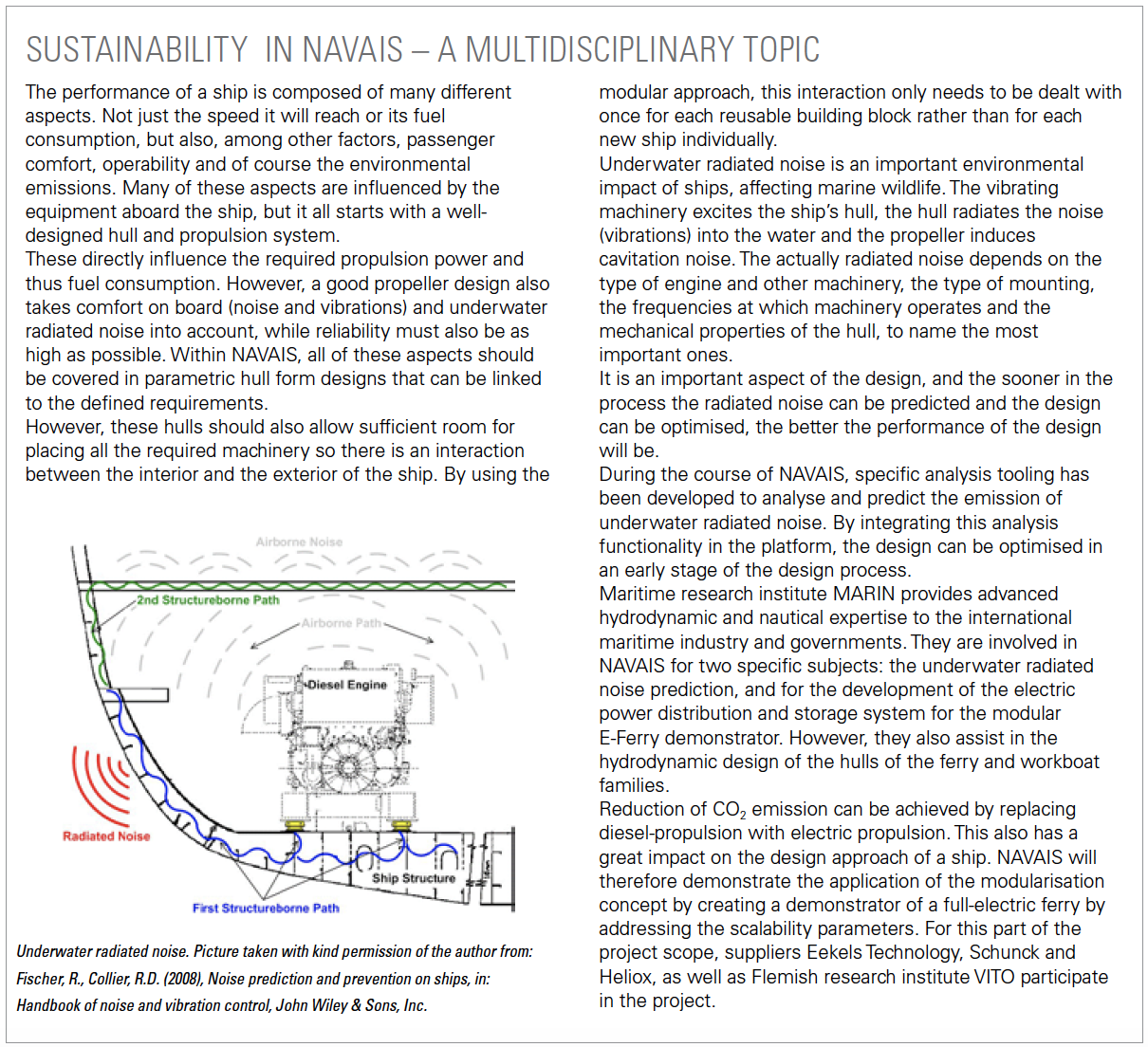
How do we get there?
First of all, we need to recognise that the main challenge is not related to understanding the concepts of systems engineering, standardisation and modularisation. These are concepts well documented and industries that create advanced, challenging, and complex products have built up experience and shared their expertise. The challenge is in adopting these “grand concepts” for the practical situation in shipbuilding.
Some experts in systems engineering may consider a ship to be essentially an aeroplane that floats on water (not air). This does little justice to the differences between these industries. For instance, the regulatory regimes in shipbuilding are not like that of aviation. And the series in shipbuilding will never be in the same range as in aviation, because client specific requirements show a greater variety (to mention only two reasons).
Cooperation is key
NAVAIS is run by a consortium that brings all the necessary points of view and knowledge together with the required expertise to make these next steps in European shipbuilding a reality. Damen pioneered standardisation in workboats, and expands this approach to more complex ships, allowing much more customisation by enlarging the reuse of available concepts, designs, and solutions. For forty years, Dassault Systèmes has been supporting industries all over the world with software solutions and associated processes.
This wealth of experience about what it takes to adopt the concept of systems engineering is brought to the NAVAIS project. Classification societies are key in the regulatory regime in shipbuilding, and Bureau Veritas participates in creating the necessary conditions for the pre-approval of modules, saving time and effort in the complete approval process. This is a key condition to make standardisation and modularisation work.
The outcomes of NAVAIS will potentially have a large impact on the European small and medium-sized enterprise (SME) supply chain and other stakeholders as well as their current business models. Building cooperation networks with the SME supply chain will be beneficial to understand the ideas, needs and concerns of European stakeholder groups, and applying their input to manufacture series of assemblies or even complete modules that need to fit directly in the European vessel modular architecture.
This cooperation is facilitated by SEA Europe as, through its associates and working groups, it can reach some 22,000 companies (from SMEs to large multinationals), which constitute the backbone of the EU maritime technology know-how and industrial sector. The project has received funding from the European’s Horizon 2020 research and innovation programme (contract no.: 769419)
EU development agenda
NAVAIS receives funding from the European Union. This is in recognition that the objectives of NAVAIS match the policy agenda of Europe. In fact, NAVAIS operates under the “Societal challenges – Smart, green and integrated transport” programme, to achieve a European transport system that is resource efficient, climate and environmentally friendly, safe, and benefits all citizens, the economy and society.
The outcome of NAVAIS activities will contribute to bringing forward innovative concepts to maintain world leadership in complex, value-added and highly specialised vessels in Europe. In addition, the objectives are fully in line with the Strategic Research Agenda, as published last year by the Waterborne Technology Platform (www.waterborne.eu). Sustainability and strengthening the role and position of SMEs are key elements of this agenda, which NAVAIS will contribute to.
To remain competitive in the future, new technologies to meet sustainability targets, need to be incorporated into the design efficiently. Without a process approach methodology, the introduction of fuel cell technology (for instance) will be difficult to achieve without a huge design impact. It is a specific element of NAVAIS to demonstrate that new technologies and novel requirements can be integrated in a structured manner.
Integrated platform
The NAVAIS solutions are based on the 3DEXPERIENCE platform, provided by project partner Dassault Systèmes, which is used by many industry leaders worldwide. It provides dedicated software solutions for specific applications (for instance, requirement management, 3D modelling, simulation). This platform is under constant development and Dassault Systèmes, through its research and development department, provides the consortium with a dedicated implementation of this platform for modular design and production in shipbuilding.
Together with experts from Damen, the processes that are needed to come to modularisation have been defined and are now being configured in the software platform (the method used is a common one: Damen defined user stories, which will be converted into use cases). At Damen Shipyards, a dedicated IT-environment has been set up, which is supported by Processia Solutions. A dedicated environment for NAVAIS is managed separately from the production environment to minimise risk.
So where are we now? Below three different projects within NAVAIS are described.
Underwater radiated noise
Prediction models for underwater radiated noise (URN) due to cavitation during acceleration and deceleration and during dynamic positioning are under consideration since those are operating conditions that occur regularly for road ferries and workboats respectively. A series of model tests has been performed and analysed to provide validation data for the computational models. Currently, all tests are being compared and used to create computational models.
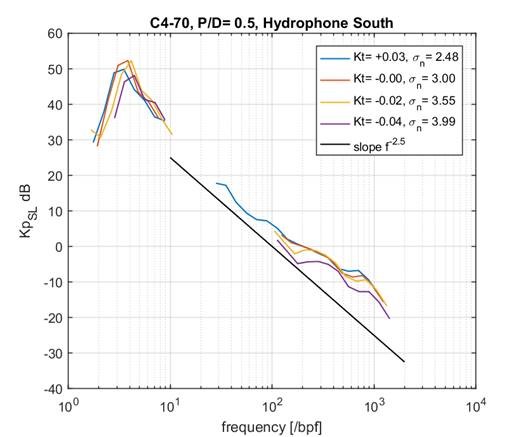
Noise levels.
An example of the non-dimensionalised noise levels (KpSL) of a four-bladed propeller in a low pitch setting is shown in the figure below. The lines show various thrust coefficients (Kt) and cavitation numbers (σn). The black line is an approximation of the slope of the spectra as used for creating the models.
To further ensure that noise level predictions are as accurate as can be, the cavitating tip vortex diameter is also used as an input for the URN prediction models. This is being determined by applying image processing and machine learning techniques on the highspeed video observations.
Modular ferry
For the ferries, the modular blocks for the electrical propulsion system have been defined. These are used to identify the interdependencies and interfaces. Secondly, the initial study into the different effects of a modular hull shape have been investigated. A table has been created with possible configurations, and that has been developed into a parametric linesplan for various car carrying vessel requirements. The effects on wave patterns have also been analysed, see the figure.
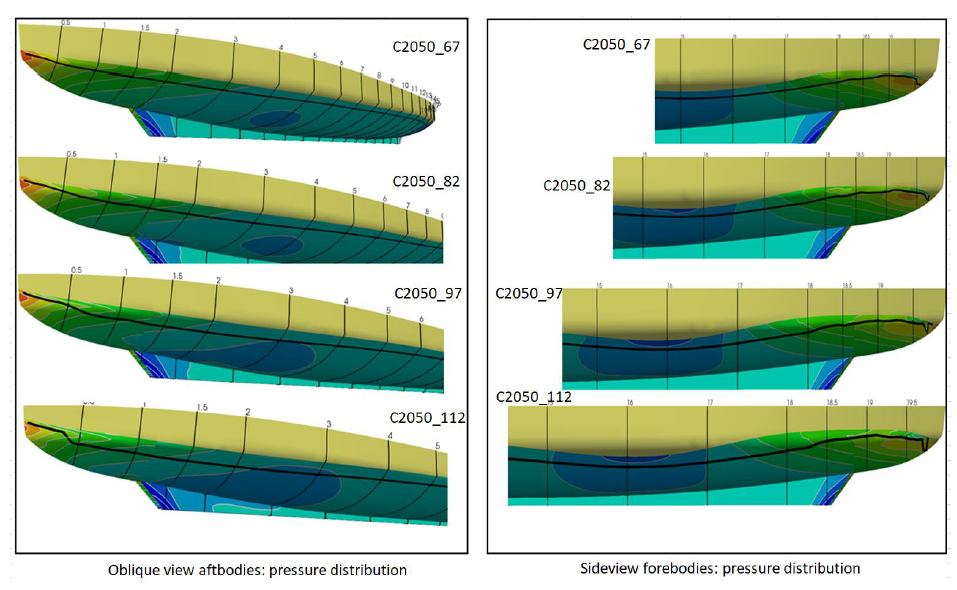
Parametric lines plans.
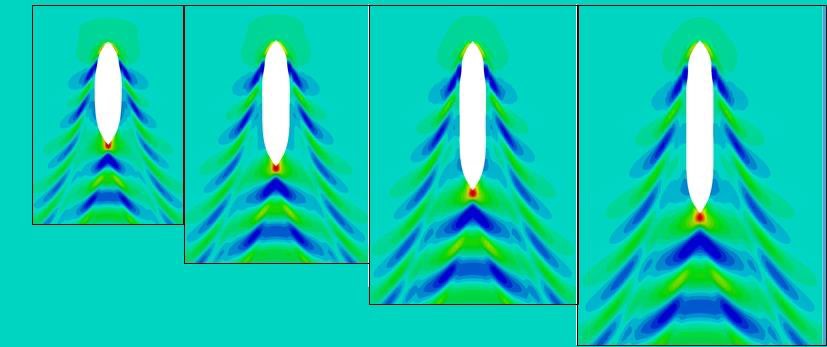
Top view of the wave pattern of four hulls with a different length.
Modular workboat
‘At Damen we have ample experience with standardisation. To take the next step, we must better organise all the information in a uniform structure. Information regarding calculations, guidelines and rules,’ explains Baldassare Messina, Work Package Lead for the modular workboat.
Messina continues: ‘To do that, we need translations, ways to effectively link information. Take a pump. We do have a drawing of a pump, and we have installation drawings in the software platform. We can connect that with 3D representations and we can attach fall kinds of information to the 3D object (like weight, calculations, references to specifications, etc.). When we have collected this information, we can configure a workboat to order, where we have a set of options and variants available, that can be combined. We can determine beforehand the impact of options on the complete ship design, and we can prove beforehand by calculations and simulations that the complete solution will work.’
In developing the feasibility, a bottom-up approach to the workboat design was taken, actually reversing the RFLP (Requirements-Functional-Logical-Physical). A study of the detailed engineering information of five different workboats and tugs was made and the components of already designed vessels were analysed.
‘From this analysis, we created a single system architecture,’ says Messina. ‘We used a bilge system for this exercise and implemented the results in two modules on the software platform. The next step is to analyse the interfaces between the subsystems in the bilge system, so that we can attach specific requirements to the subsystems. For a relatively simple system like the bilge, we can therefore relate the requirements, functional and logical information to each other.’
This approach, even when it is bottom-up, underlines the necessity to have a good definition of what the system should achieve. Requirements management is a key step in the process. ‘We obtain good understanding of the processes and are making good use of the possibilities the software platform will provide. NAVAIS will prove the concept, will show that it is possible. On the modular workboat, we work with twelve dedicated and motivated people,’ concludes Messina.
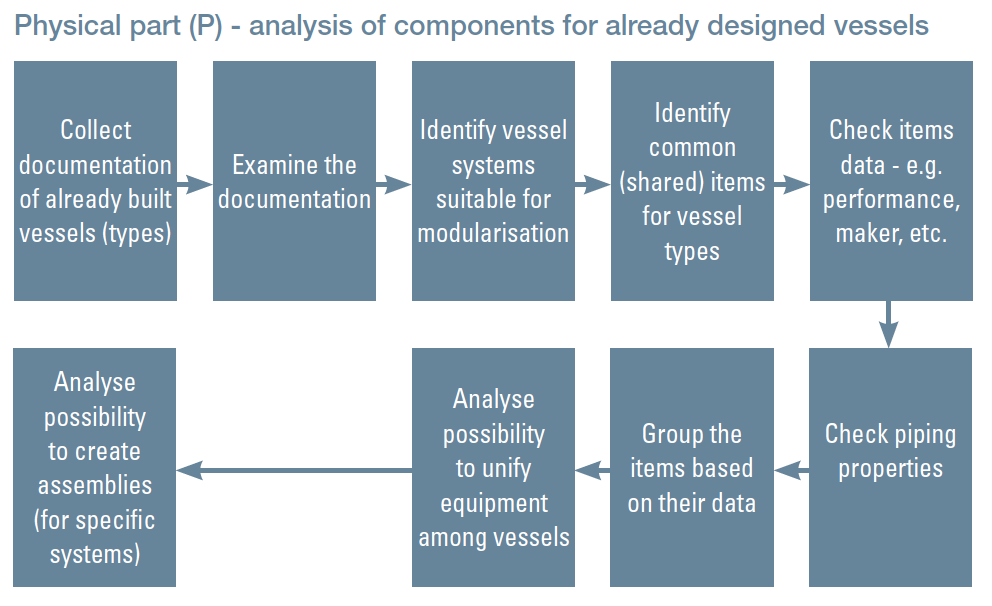
Physical parts analysis.
The road ahead
The next two years will be focused on the connecting of simulation tools and proving the NAVAIS concepts by creating the two demonstrators, hereby producing more content in the platform to be reused. In parallel, an extensive validation exercise will be run, to provide the required proof that the concept is feasible.
This will also create opportunities for other entities in the shipyard supply chain (designers, equipment and system suppliers, operators, class authorities) to get involved as stakeholder. Should you wish to know more and get involved, please contact info@navais.eu for more information and to get invited to a discussion panel on the NAVAIS method of working, and the opportunities it presents.
Picture (top): Physical parts integration.
This article appeared in SWZ|Maritime’s December 2020 issue. For more information; visit www.navais.eu or contact Maarten Deul, Program Manager at Damen Research and Development at maarten.deul@damen.com.








